Kawanectes
Kawanectes (meaning "Kawas swimmer") is a genus of elasmosaurid plesiosaur, a type of long-necked marine reptile, that lived in the marginal marine (probably estuarine) environment of Late Cretaceous Patagonia. It contains one species, K. lafquenianum, described in 2016 by O'Gorman.[1]
| Kawanectes | |
|---|---|
 | |
| Life restoration | |
| Scientific classification | |
| Domain: | Eukaryota |
| Kingdom: | Animalia |
| Phylum: | Chordata |
| Class: | Reptilia |
| Superorder: | †Sauropterygia |
| Order: | †Plesiosauria |
| Family: | †Elasmosauridae |
| Genus: | †Kawanectes O'Gorman 2016 |
| Species: | †K. lafquenianum |
| Binomial name | |
| †Kawanectes lafquenianum (Gasparini & Goñi 1985) | |
| Synonyms | |
| |
Description
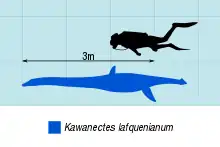
Measuring 3.8 m (12.5 ft) long and weighing 140 kg (310 lb), Kawanectes was small for an elasmosaurid.[1][2] It belongs to the "non-elongated" group of elasmosaurids, meaning that its cervical vertebrae are not extremely lengthened, neither do they show great variability in length.[3] The MCS specimen preserves 15 cervical vertebrae and 15 dorsal vertebrae, while the holotype preserves 10 caudal vertebrae; the true number of cervical and caudal vertebrae is unknown due to the incompleteness of the specimens.[1]
A combination of traits can be used to distinguish Kawanectes from all other elasmosaurids: the centra of the vertebrae are wider than they are long; the projections known as the parapophyses on the caudal vertebrae are knob-like; the ischium and pubis form a "bar" of bone that encloses two diamond-shaped openings; the ratio between the length of the humerus and the femur is unusually high (1.2); the end of the humerus bears a backward projection of bone which forms an articulating surface; and the capitulum of the femur, which likewise forms an articulating surface, is strongly convex.[1]
Although Kawanectes is similar to the somewhat-larger Vegasaurus, its bones clearly represent that of an adult due to the fusion in the vertebrae, the proportions of its cervical vertebrae are the same as Vegasaurus (if Vegasaurus was an older Kawanectes, its cervical vertebrae would be longer,[3] as with other elasmosaurids), and Vegasaurus does not have a pelvic bar (since the pelvic bar is absent in juvenile elamosaurids but present in adults, the emergence then disappearance of the pelvic bar contradicts a hypothetical growth sequence), suggesting that Vegasaurus is not the adult form of Kawanectes.[1] On the basis of three known specimens, it is proposed that the genus exhibits sexual dimorphism in terms of ilium shape, humerus to femur size ratio and sacral centrum proportions, and that females are larger than males.[4]
Discovery and naming
Kawanectes is known from the "Bentonitas Patagonicas" quarry in Rio Negro Province, Argentina. This quarry belongs to the Middle Member of the Allen Formation, which dates to the late Campanian to Early Maastrichtian of the Late Cretaceous.[5] Three specimens are known: the holotype, MLP 71-II-13-1, which consists of various parts of the axial skeleton along with a femur, a humerus, an ilium, and a foot bone; MCS PV 4, which again consists of various axial bones in addition to a scapula, part of a coracoid, both sets of ischia and pubes, part of a foot, and 389 gastroliths; and MUC Pv 92, which also contains axial elements along with a femur, two foot bones, and fragments of the limb girdles.[1]
Initially recognized as a species of Trinacromerum,[6] polycotylid affinities were later rejected for "T." lafquenianum.[7] O'Gorman named the new monotypic genus Kawanectes for "T." lafquenianum in 2016. The name combines Kawa, which refers to the Kawas Sea,[8] an ancient ocean that covered Patagonia from the Campanian to the Danian, and Greek nectes, which means "swimmer". The original specific name, lafquenianum, is the Mapuche word for "sea".[1]
Classification
In 2016, a phylogenetic analysis found that Kawanectes was a close relative to, but not a member of, the Aristonectinae.[9]
| Elasmosauridae |
| |||||||||||||||||||||||||||||||||||||||||||||||||||||||||||||||||||||||||||||||||||||||||||||
Paleoecology
With the discovery of Kawanectes, the plesiosaurian fauna of the Kawas sea (which spans both the Allen Formation and the contemporary La Colonia Formation) contains all three major lineages of Late Cretaceous plesiosaurs: non-aristonectine elasmosaurids (Kawanectes and Chubutinectes[10]), aristonectine elasmosaurids (Aristonectes[11]), and polycotylids (Sulcusuchus[12]). This is unusual, since these formations represent continental-to-marginal marine environments (i.e. not open ocean).[13][14] These plesiosaurs appear to be generally smaller than their open-ocean counterparts at adult size.[14][1]
References
- O'Gorman, J.P. (2016). "A Small Body Sized Non-Aristonectine Elasmosaurid (Sauropterygia, Plesiosauria) from the Late Cretaceous of Patagonia with Comments on the Relationships of the Patagonian and Antarctic Elasmosaurids". Ameghiniana. 53 (3): 245–268. doi:10.5710/AMGH.29.11.2015.2928. S2CID 133139689.
- Paul, Gregory S. (2022). The Princeton Field Guide to Mesozoic Sea Reptiles. Princeton University Press. p. 114. ISBN 9780691193809.
- O'Keefe, F.R.; Hiller, N. (2006). "Morphologic and Ontogenetic Patterns in Elasmosaur Neck Length, with Comments on the Taxonomic Utility of Neck Length Variables". Paludicola. 5 (4): 206–229.
- O'Gorman, José P. (2021). "The most complete specimen of Kawanectes lafquenianum (Sauropterygia, Plesiosauria): New data on basicranial anatomy and possible sexual dimorphism in elasmosaurids". Cretaceous Research. 125. 104836. doi:10.1016/j.cretres.2021.104836.
- Dingus, L.; Clarke, J.; Scott, G.R.; Swisher, C.C.; Chiappe, L.M.; Coria, R.A. (2000). "Stratigraphy and Magnetostratigraphic/Faunal Constraints for the Age of Sauropod Embryo-Bearing Rocks in the Neuquén Group (Late Cretaceous, Neuquén Province, Argentina)". American Museum Novitates (3290): 1–11. doi:10.1206/0003-0082(2000)290<0001:SAMFCF>2.0.CO;2. hdl:2246/2987.
- Gasparini, Z.; Goñi, R. (1985). "Los plesiosaurios cretácicos de América del Sur y del continente antártico". Congresso Brasileiro de Paleontología. 8: 55–63.
- Gasparini, Z.; Salgado, L. (2000). "Elasmosáuridos (Plesiosauria) del Cretácico Tardío del norte de Patagonia" [Late Cretaceous elasmosaurids (Plesiosauria) from northern Patagonia] (PDF). Revista Española de Paleontología. 15: 13–21.
- Casamiquela, R.M. (1978). "La zona litoral de la transgresión Maástrichtense en el norte de la Patagonia". Ameghiniana. 15: 137–148.
- O'Gorman, J.P.; Otero, R.A.; Hiller, N.; Simes, J.; Terezow, M. (2016). "Redescription of Tuarangisaurus keyesi (Sauropterygia; Elasmosauridae), a key species from the uppermost Cretaceous of the Weddellian Province: Internal skull anatomy and phylogenetic position". Cretaceous Research. 71: 118–136. doi:10.1016/j.cretres.2016.11.014.
- O’Gorman, José P.; Carignano, Ana Paula; Calvo-Marcilese, Lydia; Pérez Panera, Juan Pablo (2023-08-10). "A new elasmosaurid (Sauropterygia, Plesiosauria) from the upper levels of the La Colonia Formation (upper Maastrichtian), Chubut Province, Argentina". Cretaceous Research: 105674. doi:10.1016/j.cretres.2023.105674. ISSN 0195-6671.
- O'Gorman, J.P.; Gasparini, Z.; Salgado, L. (2013). "Postcranial morphology of Aristonectes (Plesiosauria, Elasmosauridae) from the Upper Cretaceous of Patagonia and Antarctica". Antarctic Science. 25 (1): 71–82. Bibcode:2013AntSc..25...71O. doi:10.1017/S0954102012000673. S2CID 128417881.
- O'Gorman, J.P.; Gasparini, Z. (2013). "Revision of Sulcusuchus erraini (Sauropterygia, Polycotylidae) from the Upper Cretaceous of Patagonia, Argentina". Alcheringa: An Australasian Journal of Palaeontology. 37 (2): 163–176. doi:10.1080/03115518.2013.736788. S2CID 131429825.
- Barrio, C.A. (1990). "Paleogeographic control of Upper Cretaceous Tidal Deposits, Neuquén Basin, Argentina". Journal of South American Earth Sciences. 3 (1): 21–49. Bibcode:1990JSAES...3...31B. doi:10.1016/0895-9811(90)90016-T.
- Gasparini, Z.; Sterli, J.; Parras, A.; O’Gorman, J.P.; Salgado, L.; Varela, J.; Pol, D. (2015). "Late Cretaceous reptilian biota of the La Colonia Formation, central Patagonia, Argentina: Occurrences, preservation and paleoenvironments". Cretaceous Research. 54: 154–168. doi:10.1016/j.cretres.2014.11.010. hdl:11336/19244.
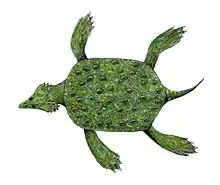
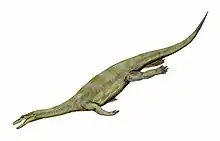


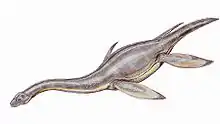
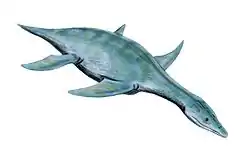
.png.webp)